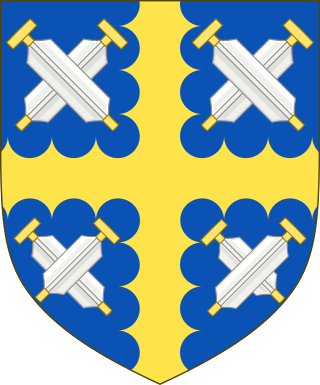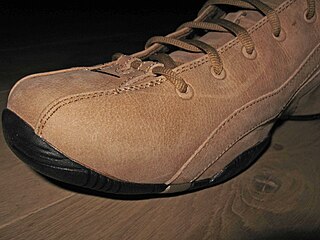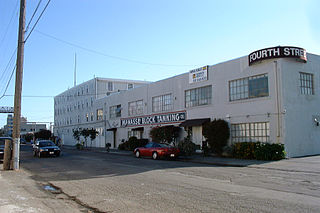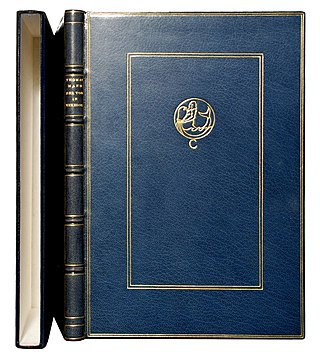
Leather is a strong, flexible and durable material obtained from the tanning, or chemical treatment, of animal skins and hides to prevent decay. The most common leathers come from cattle, sheep, goats, equine animals, buffalo, pigs and hogs, and aquatic animals such as seals and alligators.

Tanning, or hide tanning, is the process of treating skins and hides of animals to produce leather. A tannery is the place where the skins are processed.

Suede is a type of leather with a fuzzy, napped finish, commonly used for jackets, shoes, fabrics, purses, furniture, and other items.

The Worshipful Company of Curriers is one of the ancient livery companies of London, associated with the leather trade.

Nubuck is top-grain leather that has been sanded or buffed on the grain side, or outside, to give a slight nap of short protein fibers, producing a velvet-like surface. It is resistant to wear, and may be white or coloured.

Ostrich leather is the result of tanning skins taken from African ostriches farmed for their feathers, skin and meat. The leather is distinctive for its pattern of vacant quill follicles, forming bumps ranged across a smooth field in varying densities. It requires an intricate, specialised, and expensive production process making its aesthetic value costly.

The Manasse-Block Tanning Company was an American tannery founded in 1900 by August Manasse and Roy Block, whose families had leather-related businesses in Napa and San Francisco, California, respectively. The Manasse-Block tannery was relocated in 1905 from Oakland to 1300 Fourth Street in Berkeley, on a site previously used by the Deach Tannery. Manasse-Block remained in this location for 80 years, until it closed in 1986.

Morocco leather is a vegetable-tanned leather known for its softness, pliability, and ability to take color. It has been widely used in the manufacture of gloves and the uppers of ladies' shoes and men's low cut shoes, but is commonly associated with wallets, linings for fine luggage, and bookbindings.
Currie is a suburb of Edinburgh.

The leather manufacturing process are the operations taken to create leather from hides. The procedure is divided into three sub-processes: preparatory stages, tanning, and crusting. All true leathers will undergo these sub-processes. A further sub-process, surface coating, may be added into the sequence. The list of operations that leathers undergo vary with the type of leather. There are environmental impacts associated with the process.

Institute of Leather Engineering and Technology, University of Dhaka was established in 1949 for advanced research on leather. It is the largest institute of Dhaka University in terms of size. This institute has been playing a unique role in research related to leather industry since its inception. Dhaka University completes the admission process in Leather Engineering, Footwear Engineering and Leather Product Engineering.

The Igualada Leather Museum, located in Igualada, Catalonia, was created in 1954 and was the first leather museum in Spain, and the third one in Europe. The collections are displayed in two nearby buildings in Igualada: the "Cal Boyer" building, a former cotton textile factory from the late 19th century, and the "Cal Granotes" building, an 18th-century tannery.
S.B. Foot Tanning Company is a leather production facility located in Red Wing, Minnesota. It processes leather for use in the crafting of shoes, boots, belts, and leather accessories. In 2010, the factory processed nearly 6 million linear feet of hides. S.B. Foot Tanning Company is a wholly owned subsidiary of Red Wing Shoes Company, Inc. and is the principal supplier of leather to their shoe manufacturing plants. The company also supplies over 1.5 million linear feet of leather for use in the production of military footwear per year, extending a tradition that began with World War I, when the tannery supplied boot leathers for the construction of soldier boots.

Central Leather Research Institute or CLRI is the world's largest leather research institute in terms of research papers and patents. The institute located in Chennai, Tamil Nadu was founded on 24 April 1948 as a constituent laboratory under the Council of Scientific and Industrial Research.

The Tannery is a historic tannery building constructed by the colonial Moravians in Bethlehem, Northampton County, Pennsylvania. It is a limestone building built in 1761, and is part of the Bethlehem Colonial Industrial Quarter.
Humanity has used animal hides since the Paleolithic, for clothing as well as mobile shelters such as tipis and wigwams, and household items. Since ancient times, hides have also been used as a writing medium, in the form of parchment.
The Australian Leather and Allied Trades Employees' Federation (ALATEF) was an Australian trade union that existed between 1945 and 1970. It represented workers employed in the preparation of leather from hides, and the manufacture of a variety of leather and canvas goods.
Russia leather is a particular form of bark-tanned cow leather. It is distinguished from other types of leather by a processing step that takes place after tanning, where birch oil is worked into the rear face of the leather. This produces a leather that is hard-wearing, flexible and resistant to water. The oil impregnation also deters insect damage. This leather was a major export good from Russia in the 17th and 18th centuries because of its high quality, its usefulness for a range of purposes, and the difficulty of replicating its manufacture elsewhere. It was an important item of trade for the Muscovy Company. In German-speaking countries, this leather was also known by the name Juchten or Juften.
The conservation and restoration of leather objects is the process of determining the causes of deterioration, followed by deciding the best course of action for preserving the leather objects for the future.

Leather is created when an animal skin or hide is chemically treated in a process called tanning to preserve them for long term use as material for clothing, handbags, footwear, furniture, sports equipment and tools. Alligator leather is also commonly used to create similar items as mentioned above.














